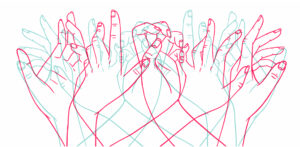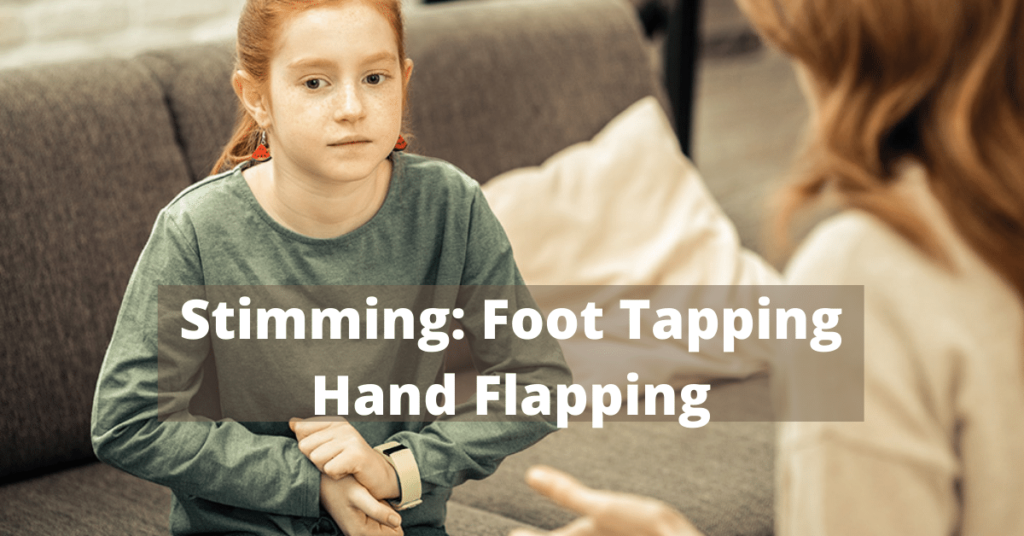Stimming is a common behavior for many with autism. Stimming is the act of repetitively performing certain gestures or behaviors. It can be used as a coping mechanism during stressful or overwhelming times. Foot tapping, hand flapping types of stimming signs may help people with autism to self-regulate and cope with their feelings.
Contents
What Is Stimming?
 Stimming is a repetitive movement or sound that is often used as a way to self-soothe, calm down, or focus. Stimming can be anything from foot-tapping and hand flapping to humming or saying the same word over and over. For some people, stimming is essential to their everyday functioning and they cannot stop doing it even if they want to. For others, it’s more of a habit or tic that can be reduced or eliminated with a little effort.
Stimming is a repetitive movement or sound that is often used as a way to self-soothe, calm down, or focus. Stimming can be anything from foot-tapping and hand flapping to humming or saying the same word over and over. For some people, stimming is essential to their everyday functioning and they cannot stop doing it even if they want to. For others, it’s more of a habit or tic that can be reduced or eliminated with a little effort.
Stimming is typically done without realizing it and occurs more frequently when an autistic person is feeling overwhelmed or anxious. This type of behavior becomes worse if someone tries to stop it from happening because this causes stress on the body which triggers stimming behavior.
There are some stims that can be harmful such as head banging or biting oneself, but these behaviors are usually rare.
Why Do People Stim?
There’s no one answer to this question since everyone stims for different reasons. Some people do it because it feels good, others do it as a way to focus or calm down, and still, others do it out of habit. Many people started to stim in early childhood before they were even aware that it was a “weird” behavior. Since many autistic people need to stim in order to function and because not everyone can tell when someone is stemming, it often goes unnoticed or at least unremarked upon until people reach school age.
Stimming In Autism

People with autism often have a very difficult time coping with their surroundings. They may experience anxiety, anger, or depression that is not related to any other condition. In order to cope with these feelings, many people self-soothe by engaging in repetitive behaviors such as hand flapping and foot tapping. These gestures are known as “stimming” and can be helpful for the individual who lives on the spectrum. Because they provide a form of sensory input which helps them regulate themselves during times of distress.
Stimming is a way of coping that helps people with autism to deal with their feelings and emotions. So it may be beneficial for parents who have children with autism to allow this type of behavior. As long as it doesn’t harm anyone else or another person’s personal property. If a child on the spectrum has a stressful day at school. It is likely that they will stim when they get home. This is not something that should be discouraged. Because it is a way for the child to cope with their day.
Types Of Stimming
Foot-tapping, hand flapping, finger-snapping/waving, rocking back and forth/pacing, headbanging/bumping into things, echolalia (repeating words or phrases spoken by someone else), repeating sounds, words, phrases.
Foot-tapping

It is actually one of the most common types of skimming you might see a child do. Kids who enjoy pushing the gas pedal in the car or tapping their foot on an imaginary brake may be stimming. You can help by getting them a toy steering wheel to hold while they are riding in the car, or get them a stress ball shaped like a car or other object that they can squeeze.
Hand flapping
Hand-flapping stimming is also common. Some people flap their hands back and forth, while others make a clapping sound. This behavior can often be reduced by teaching the child how to do it with one hand instead of both.
Screaming
Screaming is a way to release tension or anger and is often seen in kids who have been reprimanded for stimming. It’s important to remember that the child is not doing this on purpose to be disruptive, and punishing them will only make things worse. Try redirecting the behavior by providing an appropriate outlet, such as letting them scream into a pillow, going outside to scream into the open air, or letting them hit a punching bag.
Singing and chanting
Repetitive singing or chanting is often seen in kids who are trying to calm down or focus. You might hear them singing the same song over and over or repeating a phrase or sentence. This can often be reduced by giving them a quiet place to do it, such as in their room with the door closed or in a special corner designated for stimming.
Humming
Humming is another common type of stim and can be used to calm down or focus. It’s often done by making a low humming noise in the throat.
Gesturing
Some kids stim by making gestures with their hands. This might include waving their hands around, making a tapping motion, or tracing shapes in the air.
Looking around
Some kids stim by looking around constantly. They may scan the room from side to side or look up and down. This can often be reduced by providing them with something specific to focus on. Such as a toy or picture, or by giving them something to look forward to.
Tapping things

Some kids stim by tapping their fingers on things. They might drum their fingers on the table, tap their pencil against the desk, or click a pen repeatedly. This can often be reduced by removing all sharp pencils and pens from the area, keeping a fidget toy handy, or giving them a stress ball to squeeze.
Headbanging
Kids who headbang may bang their head against the wall or flip it back and forth. This is often a way to communicate frustration, so punishing them for doing this will only make things worse. If you have older children in the house, you might consider blocking off areas where the child can go to be alone when they are upset.
Biting
Some kids stim by biting things. They may bite their nails, chew on their clothing, or bite themselves. This can often be reduced by keeping their hands and nails trimmed short, having them wear gloves or mittens, and providing them with a stress ball to chew on.
There are many different types of stemming do, and most kids at least one of them occasionally. While it may be disruptive at times, stimming is generally not harmful and can even be helpful in some ways.
How To Make Stimming(Foot tapping, Hand Flipping) Less Disruptive?
 It generally helps to redirect the behavior, but it may take some experimenting to find what works best for your child. Here are just a few examples:
It generally helps to redirect the behavior, but it may take some experimenting to find what works best for your child. Here are just a few examples:
- A fidget toy that can be held in the hands and squeezed or manipulated, such as a Koosh ball or Silly Putty. Another option is to find finger-like toys that can be worn on the hands. Like finger puppets, gloves shaped like animals or cartoon characters, etc.
- Chewing gum or using a straw for drinking (although this may increase drooling).
- Playing with playdough or squeezing putty. You might want to make your own playdough by mixing equal parts salt, flour, and water.
- Jumping jacks or other movement exercises (even running in place if the ground is not available).
Tips For Parents To Help Their Kids With Stimming
The most important thing to realize is that you can’t make your child stop doing something that they really need in order to function without offering a suitable alternative. However, there are some things you can do to help minimize the disruptive effects of foot-tapping, hand flapping stimming:

1. Try to be aware of when your child is stimming and what they’re stimming with. This will help you to be more prepared for it and know how to react.
2. If possible, create a designated space for your child to stim in that is quiet and free from distractions. This could be a room in your house, a corner of the backyard, or even a special spot at school.
3. If your child is stimming in public, try to find ways to accommodate them. You should not draw too much attention to them. For example, you might let them stim when they’re in the car. By giving them a special toy or snack that they can hold and play with.
Conclusion
Stimming is a type of self-stimulatory behavior that children and adults with autism engage in to produce sensory input. The most common stimming behaviors are hand flapping, foot-tapping, rocking back and forth or side to side, spinning objects around the fingers, twirling string on one’s finger, making loud noises like clapping hands together or snapping fingers as well as running fingers along surfaces such as sandpaper. These forms of stimming can be helpful for those who may need more stimulation than what they’re getting from their environment. For some people with autism, these types of activities help them regulate themselves better. This helps them manage their anxiety levels and emotions too.
If you are looking for affordable Online Counseling MantraCare can help: Book a trial therapy session


